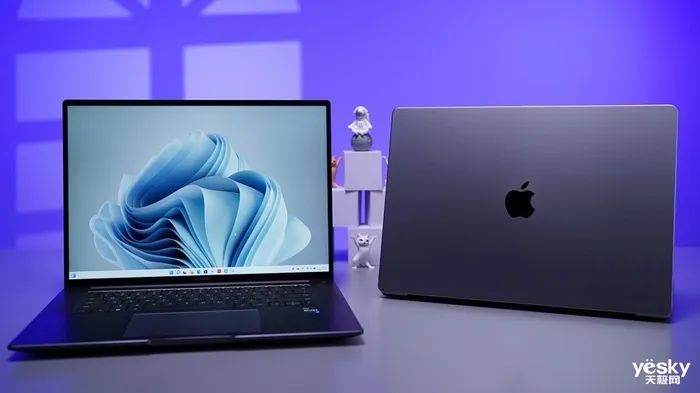 And from this year, there are two more highlights in the market segment of all-round notebooks or high-performance thin and light notebooks: Intel's 12th-generation Core with high-performance hybrid architecture and Apple's more complete self-developed chips.
And from this year, there are two more highlights in the market segment of all-round notebooks or high-performance thin and light notebooks: Intel's 12th-generation Core with high-performance hybrid architecture and Apple's more complete self-developed chips.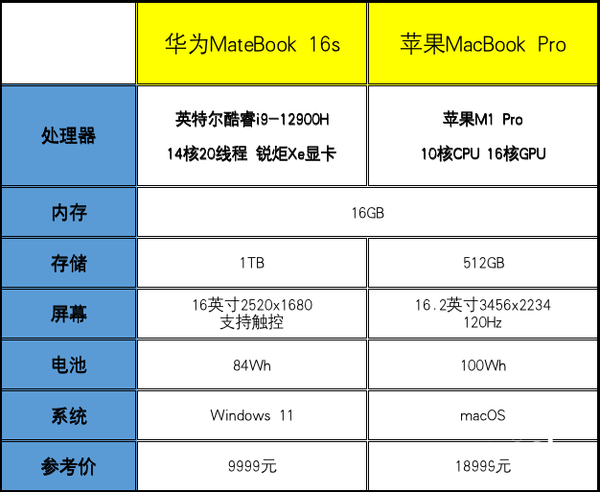 Although the Core i9-12900H and the M1 Pro are not the "flagships" of the two, they are also very representative, and the Huawei MateBook 16s has a similar body size to the Apple MacBook Pro, which is easy to compare.
Although the Core i9-12900H and the M1 Pro are not the "flagships" of the two, they are also very representative, and the Huawei MateBook 16s has a similar body size to the Apple MacBook Pro, which is easy to compare.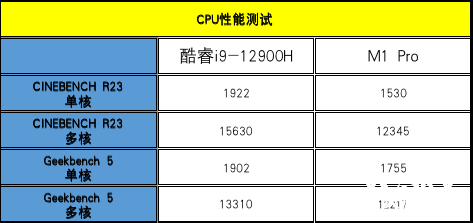 It can be seen that the Core i9-12900H leads the overall performance in terms of performance. In the CINEBENCH R23 test, the single-core and multi-core performance leads the M1 Pro by 26% and 27% respectively, which also lays the foundation for Huawei MateBook 16s to provide more efficient productivity.
It can be seen that the Core i9-12900H leads the overall performance in terms of performance. In the CINEBENCH R23 test, the single-core and multi-core performance leads the M1 Pro by 26% and 27% respectively, which also lays the foundation for Huawei MateBook 16s to provide more efficient productivity. 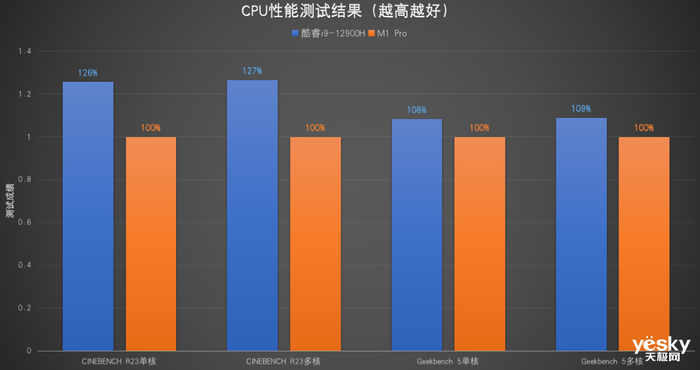 Web page performance test through WebXprt 4, the results are as follows.
Web page performance test through WebXprt 4, the results are as follows.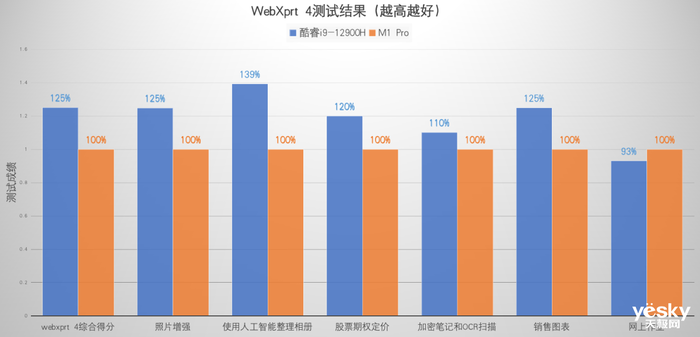 In terms of overall results, the Core i9-12900H leads the M1 Pro by 25%. In the 6 sub-test items, except for online homework, which lags behind by about 7%, the rest are in the lead, and the advantage of using artificial intelligence to organize albums is close to 40%.
In terms of overall results, the Core i9-12900H leads the M1 Pro by 25%. In the 6 sub-test items, except for online homework, which lags behind by about 7%, the rest are in the lead, and the advantage of using artificial intelligence to organize albums is close to 40%.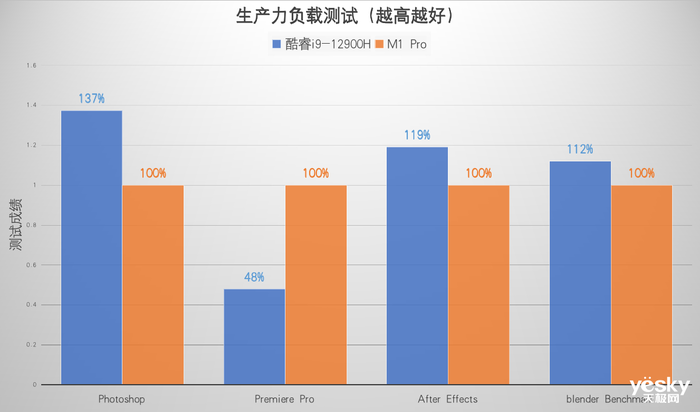 Overall, the Core i9-12900H takes the lead in the three tests of PS, AE, and blender Benchmark (CPU), and the PS performance advantage reaches 37%. However, in the heavy load test of PR, the performance of the M1 Pro is very eye-catching, leading by more than 50%.
Overall, the Core i9-12900H takes the lead in the three tests of PS, AE, and blender Benchmark (CPU), and the PS performance advantage reaches 37%. However, in the heavy load test of PR, the performance of the M1 Pro is very eye-catching, leading by more than 50%.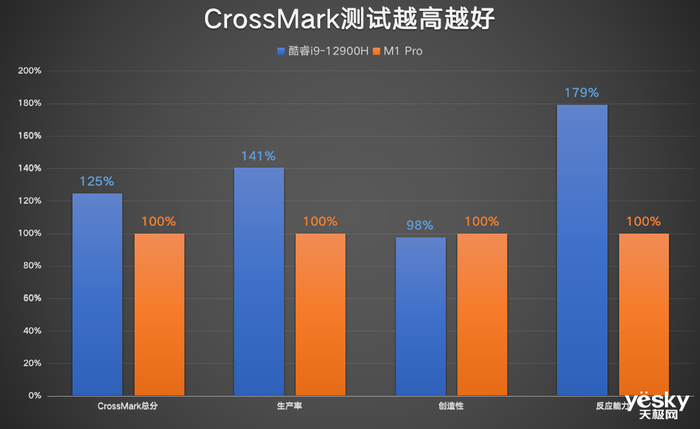 As a cross-platform testing tool, CrossMark can more comprehensively detect system performance. The Core i9-12900H is significantly ahead of the M1 Pro, especially in terms of responsiveness, which is close to 80%. However, the creative side is still slightly behind, with the M1 Pro leading by about 2%.
As a cross-platform testing tool, CrossMark can more comprehensively detect system performance. The Core i9-12900H is significantly ahead of the M1 Pro, especially in terms of responsiveness, which is close to 80%. However, the creative side is still slightly behind, with the M1 Pro leading by about 2%.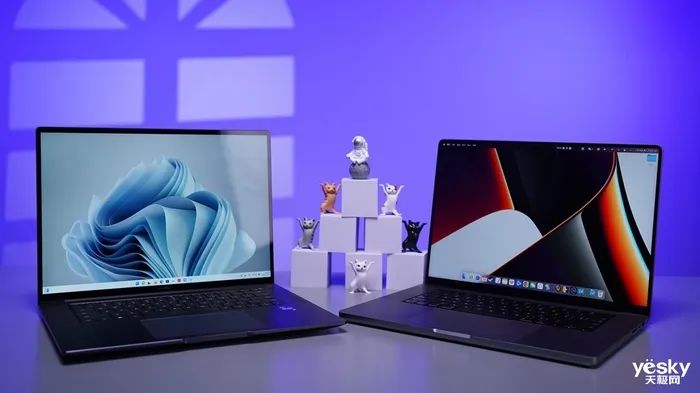 The following are the comparative results of productivity, web page performance, and CrossMark when plugged and unplugged.
The following are the comparative results of productivity, web page performance, and CrossMark when plugged and unplugged.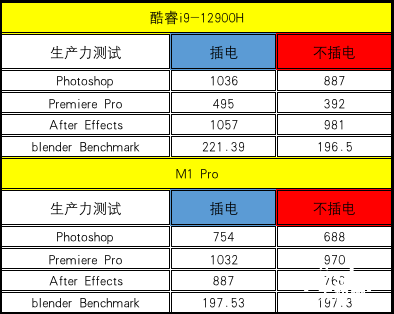
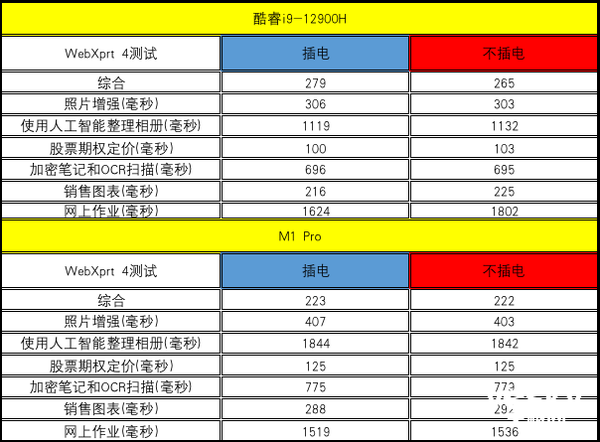
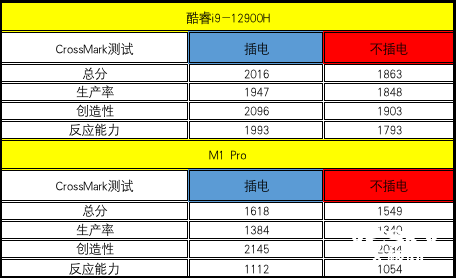 Therefore, in the case of unplugged, the M1 Pro has narrowed the gap between the Core i9-12900H and the Core i9-12900H in some tests, but in PS, AE, AI test of web page performance, CrossMark response ability and other tests, the lag is still relatively obvious.
Therefore, in the case of unplugged, the M1 Pro has narrowed the gap between the Core i9-12900H and the Core i9-12900H in some tests, but in PS, AE, AI test of web page performance, CrossMark response ability and other tests, the lag is still relatively obvious. 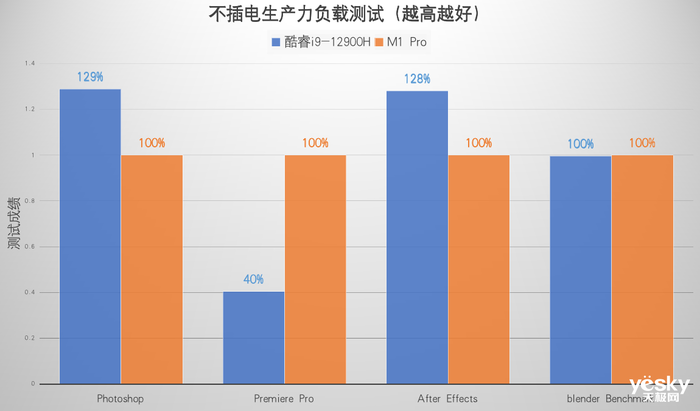
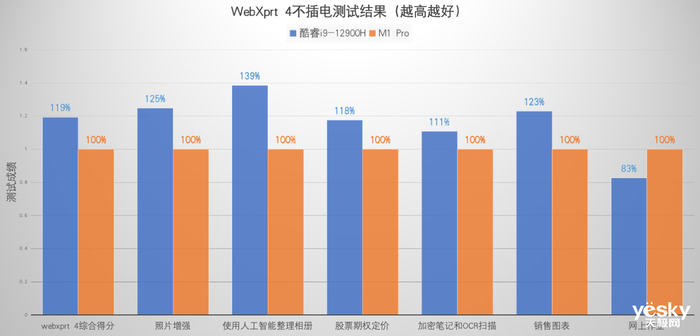
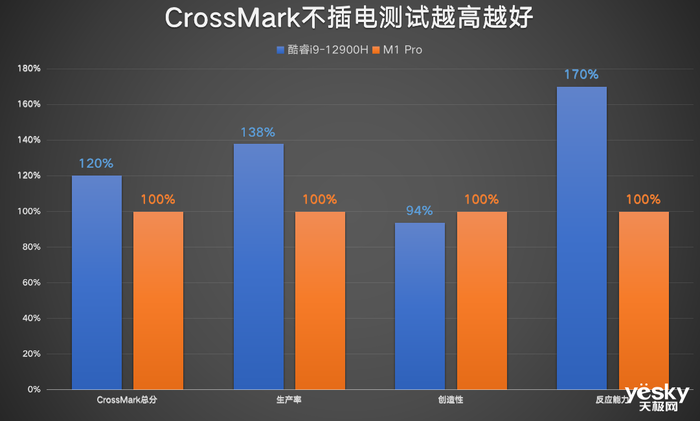 Next, let's take a look at the battery life. It is only to compare the maximum battery life of the device. Obviously, the MacBook Pro with a large 100Wh battery is better.
Next, let's take a look at the battery life. It is only to compare the maximum battery life of the device. Obviously, the MacBook Pro with a large 100Wh battery is better.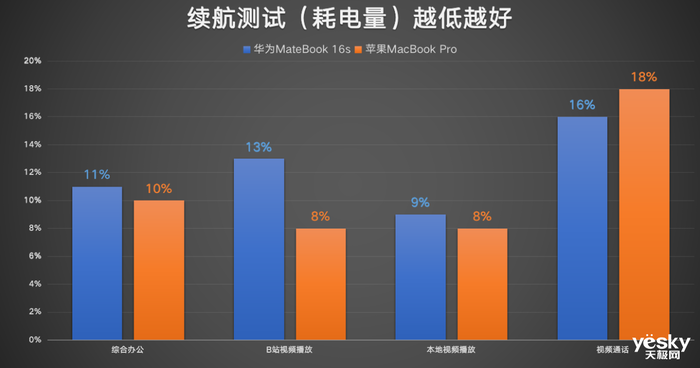 Although the overall power consumption of the MacBook Pro is lower, in addition to video playback at station B, the Huawei MateBook 16s has not been opened up, so overall, the M1 Pro has an advantage in terms of battery life, while the standard Core i9 -12900H is not a "power killer" either.
Although the overall power consumption of the MacBook Pro is lower, in addition to video playback at station B, the Huawei MateBook 16s has not been opened up, so overall, the M1 Pro has an advantage in terms of battery life, while the standard Core i9 -12900H is not a "power killer" either.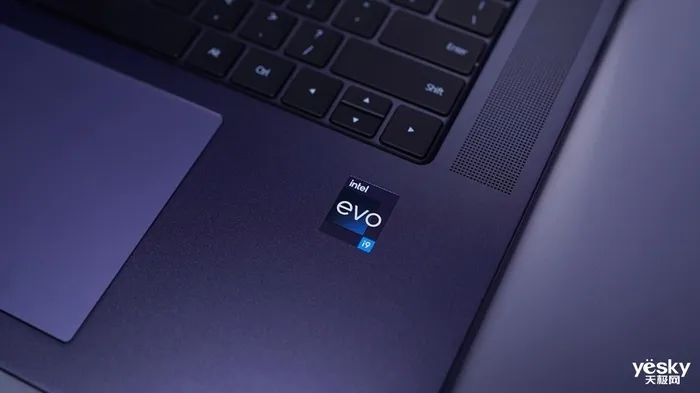 At the same time, in the face of the menacing Apple M1 chip, Intel not only brought out innovations such as high-performance hybrid architecture and hardware thread scheduler, but also Evo certification centered on user experience.
At the same time, in the face of the menacing Apple M1 chip, Intel not only brought out innovations such as high-performance hybrid architecture and hardware thread scheduler, but also Evo certification centered on user experience.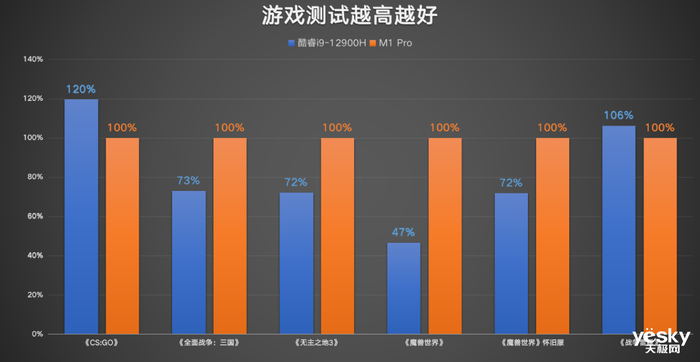 It can be seen that in games such as "CS:GO" and "War Thunder", the Huawei MateBook 16s equipped with the Core i9-12900H maintains a 20% and 6% lead. However, in the test of "World of Warcraft" official server and nostalgic server, M1 Pro has performed very well.
It can be seen that in games such as "CS:GO" and "War Thunder", the Huawei MateBook 16s equipped with the Core i9-12900H maintains a 20% and 6% lead. However, in the test of "World of Warcraft" official server and nostalgic server, M1 Pro has performed very well.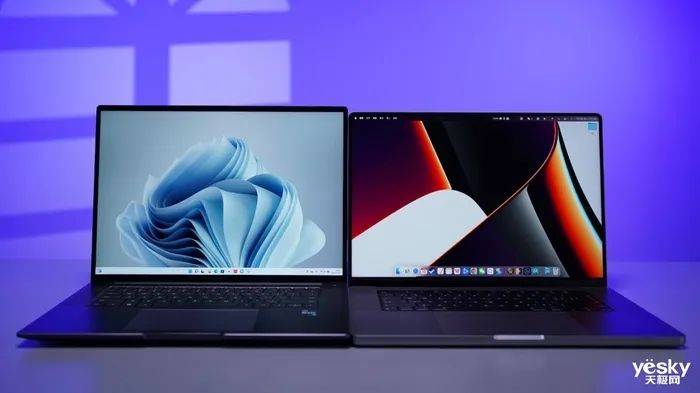 Of course, having a stronger GPU does not mean that the Mac can become a "game book", but only expands its application scenarios. At present, there is still a big gap between Apple's self-developed chips in the game field and the x86 platform.
Of course, having a stronger GPU does not mean that the Mac can become a "game book", but only expands its application scenarios. At present, there is still a big gap between Apple's self-developed chips in the game field and the x86 platform.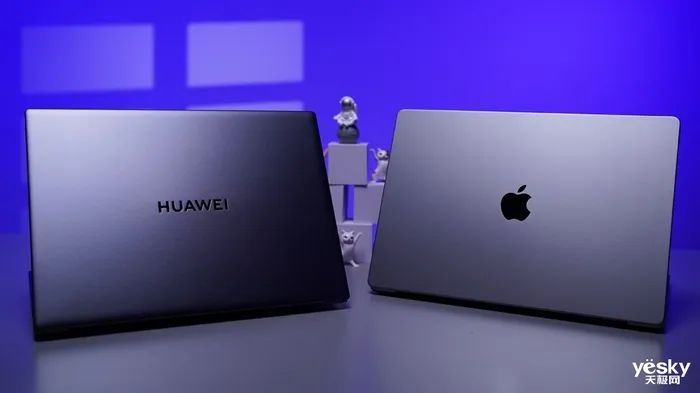 But if you don't particularly mind the system, then I recommend choosing Huawei MateBook 16s with Core i9-12900H.
But if you don't particularly mind the system, then I recommend choosing Huawei MateBook 16s with Core i9-12900H.END
celestial net
, like 1
feel good please give me a "watching"